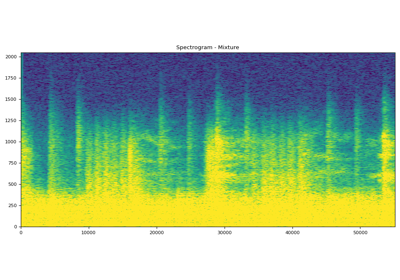HDemucs¶
- class torchaudio.models.HDemucs(sources: List[str], audio_channels: int = 2, channels: int = 48, growth: int = 2, nfft: int = 4096, depth: int = 6, freq_emb: float = 0.2, emb_scale: int = 10, emb_smooth: bool = True, kernel_size: int = 8, time_stride: int = 2, stride: int = 4, context: int = 1, context_enc: int = 0, norm_starts: int = 4, norm_groups: int = 4, dconv_depth: int = 2, dconv_comp: int = 4, dconv_attn: int = 4, dconv_lstm: int = 4, dconv_init: float = 0.0001)[source]¶
來自 Hybrid Spectrogram and Waveform Source Separation [Défossez, 2021] 的 Hybrid Demucs 模型。
另請參閱
torchaudio.pipelines.SourceSeparationBundle:帶有預訓練模型的源分離 pipeline。
- 引數:
sources (List[str]) – 源名稱列表。列表可包含以下源選項:[
"bass","drums","other","mixture","vocals"]。audio_channels (int, optional) – 輸入/輸出音訊通道數。(預設值: 2)
channels (int, optional) – 初始隱藏通道數。(預設值: 48)
growth (int, optional) – 在每個層增加隱藏通道數的因子。(預設值: 2)
nfft (int, optional) – FFT bins 的數量。請注意,更改此值需要仔細計算各種形狀引數,對於混合模型,這不會直接生效。(預設值: 4096)
depth (int, optional) – 編碼器和解碼器中的層數。(預設值: 6)
freq_emb (float, optional) – 如果大於 0,則在第一個頻率層後新增頻率嵌入,實際值控制嵌入的權重。(預設值: 0.2)
emb_scale (int, optional) – 相當於縮放嵌入學習率。(預設值: 10)
emb_smooth (bool, optional) – 使用平滑嵌入(相對於頻率)初始化嵌入。(預設值:
True)kernel_size (int, optional) – 編碼器和解碼器層的 kernel_size。(預設值: 8)
time_stride (int, optional) – 合併後的最終時間層的 stride。(預設值: 2)
stride (int, optional) – 編碼器和解碼器層的 stride。(預設值: 4)
context (int, optional) – 解碼器中 1x1 卷積的上下文。(預設值: 4)
context_enc (int, optional) – 編碼器中 1x1 卷積的上下文。(預設值: 0)
norm_starts (int, optional) – 開始使用組歸一化的層。解碼器層按相反順序編號。(預設值: 4)
norm_groups (int, optional) – 組歸一化的組數。(預設值: 4)
dconv_depth (int, optional) – 殘差 DConv 分支的深度。(預設值: 2)
dconv_comp (int, optional) – DConv 分支的壓縮因子。(預設值: 4)
dconv_attn (int, optional) – 從此層開始在 DConv 分支中添加註意力層。(預設值: 4)
dconv_lstm (int, optional) – 從此層開始在 DConv 分支中新增一個 LSTM 層。(預設值: 4)
dconv_init (float, optional) – DConv 分支 LayerScale 的初始比例。(預設值: 1e-4)
- 使用
HDemucs的教程
方法¶
forward¶
- HDemucs.forward(input: Tensor)[source]¶
HDemucs 前向傳播呼叫
- 引數:
input (torch.Tensor) – 輸入混合張量,形狀為 (batch_size, channel, num_frames)
- 返回:
- 張量
輸出張量,拆分為源,形狀為 (batch_size, num_sources, channel, num_frames)
工廠函式¶
構建低 nfft (1024) 版本的 |
|
構建中等 nfft (2048) 版本的 |
|
構建高 nfft (4096) 版本的 |

